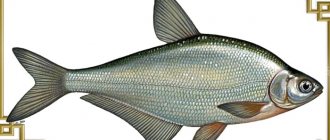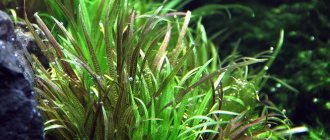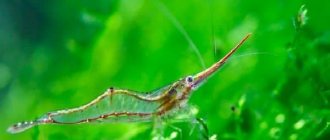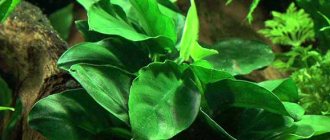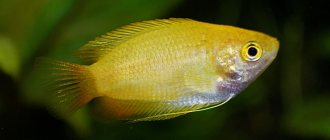Description
The cochlear leech (six-eyed klepsina, glossifonia) is a member of the family of flat leeches. Its dimensions are quite miniature - 15 - 20 mm. Therefore, they are often not noticed and are brought into the aquarium along with plants (bought in a store or brought from a nearby pond).
The parasite has an elongated body, narrowing towards the tail, and a wide head, which gives it a teardrop shape.
The color of the clepsin is usually brown or olive-brown with speckles, and it is capable of attaching to the body of the snail using a suction cup. A special proboscis allows it to suck out a small snail from its shell. And if the mollusk turns out to be larger, the leech will suck its blood.
When snail leeches sense danger, they immediately curl up into balls. If you turn them over on their backs, you can see the eggs or small babies that are attached to the abdominal part of the adults. It is customary for leeches to carry their offspring on themselves. While the cubs are not strong and are not able to lead an independent life, they feed on the prey of the adult clepsin to which they are attached.
Parasites reproduce sexually, being hermaphrodites. Their lifespan usually does not exceed two years.
Each adult individual of glossiphonia is capable of reproducing offspring in numbers from one to several dozen similar creatures. Therefore, a snail leech in an aquarium can become a real problem. If you do not immediately take measures to combat it, the aquarium can become a breeding ground for these invertebrates.
Signs
Adult leeches are clearly visible due to their size. They can be recognized by their worm-like appearance. They have an extensible, segmented body and disc-shaped suckers at both ends. The anterior (oral) sucker is usually noticeably smaller than the posterior one. Leeches can be seen both on fish and separately, and more often separately. In the latter case, they swim, making wave-like movements, or crawl along some surface, stretching out and forming loops. After leeches leave their host fish, they may hide among decorative objects. And yet, their presence in the aquarium will be obvious, since the fish will have red or whitish round wounds on its body - bite marks, which may be subject to a secondary bacterial or fungal infection. There are other types of tissue damage - for example, ulcers that are similar in appearance to leech bites, and their occurrence is more likely. Therefore, if you suspect that leeches are present in the aquarium, look for confirmation of your suspicions by examining the undersides of stones and plant leaves. Look for signs of the presence of egg cocoons - they are black or brown, oval in shape and sometimes occur in clusters. One of the signs of leech infestation associated with the behavior of fish is lethargy caused by anemia resulting from blood loss. Conversely, fish can be unusually restless. Not all water leeches parasitize fish. Therefore, the presence of adult leeches in the aquarium (except when they are directly on the fish) or their cocoons does not indicate the presence of a problem if no bite wounds are visible on the body of the fish. Leeches that parasitize fish are not always easy to distinguish from harmless ones.
Danger of leeches
The mouthparts of clepsins are equipped with a fleshy proboscis, which they use to suck the blood of small aquatic invertebrates that have thin integuments. The main target of these parasites are snails, from which they received their second name - snail leeches.
Coils and pond snails most often suffer from glossiphonia. But mollusks that cover the entrance to the shell with a lid are attacked by leeches much less often.
Once in an aquarium with tropical mollusks, clepsins are capable of destroying them. And if they cannot find other victims, even fairly large ampullaria will suffer.
Small fish have a particularly difficult time: the leech practically bites into their body, after which it begins to eat the flesh through the wound.
The danger of the snail leech for humans also exists: it can attach itself to him. You should not give up in an aquarium where clepsins live. The bite site may fester, so it is immediately treated with antiseptic agents.
The main points for placing leeches for hirudotherapy
Classic points for placing leeches
The simplest method of placing leeches is to use the classical acupuncture scheme. She will tell you where to place the biting creature correctly in order to get the maximum effect and not harm the body.
A hypertensive crisis can be quickly removed by using leeches on the tailbone area and behind the ears.
If we are talking about inflammation, leeches are placed on this area or on the skin projection of the corresponding organ, next to it. If there is congestion in the maxillary and frontal sinuses, they are placed on the sides of the nose or above the eyebrows.
If your eyesight fails, you need to place bloodsuckers on the neck along the spinal column. For headaches and migraines, leeches should suck blood on the mastoid processes behind the ears, and for osteochondrosis, displacement of the cervical vertebrae, which has caused a deterioration in blood supply, they are placed on the corner parts of the lower jaw.
To treat the liver, pancreas and gall bladder, leeches are placed in the right hypochondrium, on the navel and in the side of the abdomen. The genitourinary system is treated with leeches on the tailbone and lower abdomen.
If a person has various diseases of the cardiovascular system, especially after myocardial infarction, the use of several leeches over the cardiac area will help speed up recovery. They will speed up the healing process of the rupture and cleansing of necrotic tissue.
To get rid of runny nose and colds, problems with the respiratory system, you need to place leeches around the anus. In some cases, they are placed on the mucous membranes, even in the vagina. But such manipulations should still be entrusted to an experienced specialist.
Read my blog and you will learn in detail how and where to properly apply leeches for specific diseases.
How do leeches get into an aquarium?
Most often, glossiphonium is brought into aquariums along with plants, soil, live food and mollusks that have not been quarantined.
Any living creature must be kept in a separate container (quarantine aquarium) for at least 2 weeks. Plants and decorations must be disinfected.
It is best to purchase live food deep-frozen from trusted retailers.
Quarantined snails should be closely monitored. If they have lost activity, spend a lot of time inside the shell, and dark spots have become noticeable on their bodies, they may be infested with leeches. They will need to be treated and then observed for a few more weeks to observe their behavior.
Prevention
Aquatic animals collected from the wild as live food should be carefully inspected for the presence of adult leeches. Do not plant aquatic plants from the pond in the aquarium, as they may contain leeches or their eggs. Stones, driftwood and gravel collected from fish-inhabited waters should be immersed in boiling water as a precaution. Carefully inspect the fish you plan to buy to make sure they are free of leeches and other large parasites.
How to fight snail leeches
The question of how to get rid of aquarium leeches in an aquarium, unfortunately, does not have a clear answer. Today there is no single correct method of combating this scourge. Therefore, those who start it should be patient.
Most of the drugs used to fight snail leeches can harm the mollusks themselves.
Mechanical removal of clepsin is the safest for the ecology of a home pond, but it is a rather labor-intensive process that requires care.
Snail leeches are removed individually from the aquarium using tweezers. But first you need to find them. Many parasites will sense danger and quickly hide in hard-to-reach places, including snail shells.
To force the glossiphonium to leave the mollusk’s “house”, salt baths are used. Snail for 10 min. placed in a container with saline solution (1 teaspoon of salt per 400 ml of water). After this, the leeches usually leave their shelter. After this, the snail can be sent to a quarantine aquarium or to a general aquarium, if you are sure that all its “passengers” have left the shell.
You can use salt baths no more than once a week, so as not to harm the snails. While they are in quarantine, the main aquarium can be treated with chemicals. This measure will help ensure that the remaining parasites are destroyed.
All chemical means of controlling snail leeches pose a danger to aquarium snails. Therefore, in the process of fighting klepsins, some percentage of mollusks almost always die.
Video
Leech is a distinctive bait. How to easily get a leech.
Parasites that live in river fish. Part two LEECH bloodsucker! Fish of the Amur.
WHAT IF YOU PUT A STEAK AND AQUARIUM FISH INTO 100 HUNGRY LEECHES?
What Happens If You Throw Pike at the Piranhas. We're flying to America. Guinness Record
Chemical methods
Chemicals are not the best way to get rid of snail leeches, as they negatively affect other invertebrate inhabitants of aquariums and some types of fish.
After using chemicals, you should completely replace the water in the aquarium and siphon the soil. During treatment, remove the ultraviolet lamps and turn off the water aeration.
The well-known drug “Praziquantel” at a dosage of 250 mg per 100 liters of water effectively fights leeches, but can kill up to 75% of mollusks.
Products designed to kill planaria will also help get rid of snail leeches without harming fish, shrimp, or plants. It can seriously harm snails. The course of “treatment” of the aquarium is 3 days, but if in the near future the clepsins are still present in the aquarium, it will require additional treatment once every two weeks. The product is added to water once at the rate of:
- 1 measuring spoon per 50 liters of water on the first day,
- half a scoop on the second day,
- and a quarter - on the third.
With a large number of leeches on the second and third days, it is not necessary to reduce the dosage of the drug.
Another drug to combat snail leeches is “Tetra Medica General Tonic” from the manufacturer Tetra. It is used at the rate of 1 cap of the product per 40 liters of water. There should be no shrimp in the aquarium, otherwise they will die.
How many leeches can be placed per session and per course?
After a person learns how to apply leeches correctly, he needs to master the frequency and intensity of treatment. In most cases, it is selected individually, based on the following useful recommendations:
- Leeches can be used at intervals of 3–4 days, sometimes increasing the gap to 7 days.
- For one procedure, 3–5, sometimes 2–8 leeches are usually used. A single quantity almost never exceeds 10 pieces.
- The average course of hirudotherapy lasts from 3 to 6 weeks.
- This course takes from 30 to 100 leeches.
- It is recommended to use no more than 2 – 3 course procedures during the year.
- In the first session, 2–4 leeches are usually placed, increasing their number in subsequent approaches to 6 pieces.
- The number of bloodsuckers can be calculated from the approximate volume of blood loss as a result of the procedure. Each animal drinks 5–15 ml of blood. This volume must be multiplied by 2 due to the fact that blood will continue to flow after the procedure is completed. Knowing the patient’s parameters and his physical condition, health and tolerance to blood loss, it is possible to accurately calculate the required number of leeches.
- The frequency of sessions is determined by the patient’s health status and his reaction to the use of leeches.
- During treatment, it is necessary to monitor the blood picture. If tests show a sharp change in important indicators, hirudotherapy will have to be stopped. This is especially true for reducing the iron content in the blood, which can cause the development of anemia.
With the right approach, procedures are usually easily tolerated and avoid various problems and difficulties.
Leech trap
Another non-chemical method of controlling parasites is a leech trap in an aquarium. It can be made from a plastic bottle, in which several small holes are first made. A piece of raw meat is placed inside the container for bait. You can simply wrap it in gauze and wait for the leeches to attach. Then the meat with the glossiphonies attached is removed from the aquarium and discarded.
There are ready-made glass traps for snail leeches and planaria on sale.
How to stop bleeding after hirudotherapy
In most cases, bleeding from skin punctures lasts several hours, sometimes 5–6. This is a natural phenomenon, since the blood is thinned by special enzymes produced by leeches.
In order to stop bleeding on your own, you do not need to use any extraordinary measures. It is enough to simply apply a dry sterile cloth or bandage to the damaged area, securing the dressing with an adhesive plaster. The bandage will get wet at first and will need to be changed frequently.
The bleeding will then stop, but it is not recommended to remove the dry dressing for the next 24 hours.
In my practice, there were only three cases when I had to resort to the help of a surgeon and stitch up the wound. Carefully choose the points where you place the leeches.
Where can you buy medicinal leeches for treatment?
If you want to be treated with leeches yourself, and not from a specialist, you will have to purchase leeches yourself and care for them. Hirudotherapy at home is quite possible and not too complicated. However, you should take a responsible approach to choosing leeches.
So where can you buy leeches for treatment to be sure of their quality? It would seem that private distributors offer them at several times cheaper. But remember: you cannot save on your health! Under no circumstances buy leeches from dubious sellers and companies - the leeches may turn out to be wild, caught in natural bodies of water. And who knows who they bit before you? Again, the environmental situation in the world leaves much to be desired.
It is quite possible that by using such leeches, instead of helping your health, you will harm it. The leech, of course, is a unique creature; it disinfects many sources of infection. But is that all? This is unknown to science at this stage. Therefore, it’s still not worth the risk.
Leeches should be purchased exclusively in pharmacies or specialized stores. There you will buy medicinal leeches grown in special conditions in biofactories. Leeches, like any medicine, must be accompanied by a certificate. Leeches grown in a biofactory are under the control of specialists from the moment they are born. As a result, they are safe and guarantee you the most effective treatment.
Do not let your guard down when purchasing leeches. Healthy leeches are active: they swim, and if you touch them, they resist and wriggle. You should not take sluggish leeches; they may not be completely healthy.
Caring for medicinal leeches after the procedure
In official hirudotherapy, leeches are equated to disposable syringes: after one application to the patient’s skin, they are destroyed. But some hirudotherapists are of the opinion that leeches can be reused - of course, exclusively for the same patient. However, for specialists this is unnecessary worry - it is much easier to order leeches from a specialized center and destroy them after use.
They mate at a strictly defined time, called the mating season. This continues for about a month. After mating, the leeches are placed in three-liter jars, which are called queen cells.
The queen cells are pre-prepared: wet peat is placed on the bottom and covered with moss. Peat soil is favorable for the development of cocoons - the offspring of leeches - and moss regulates humidity. The leech digs a shallow hole in the soil, where it lays a cocoon. Small leeches, which leech breeders call filaments, emerge from the cocoon.
At home, leeches can be reused. The only thing to remember when caring for leeches after the procedure is that you need to use them to treat only one person and do this no earlier than 3 months after the bite - because only after such a time will the leech get hungry enough.
But even if you decide that it is much easier to buy other leeches for the next course, you may still have to take care of your “healers”, because one course will require about 50 of them. This will take a couple of weeks, and during this period you will have to try to prevent your “healers” from dying.
Complications after hirudotherapy and how to treat them
What is a prefix reaction during treatment with leeches?
In some cases, complications may occur. You need to be prepared to recognize them and understand how to deal with them effectively.
The most common complications that occur when using hirudotherapy are:
- Allergic reactions. They appear quite often, especially if you use leeches repeatedly or during subsequent sessions. They are mainly manifested by swelling, urticaria and itching, and disappear after taking antihistamines. In extremely rare situations, people with weakened immune systems may develop anaphylactic shock, which requires urgent hospitalization.
- Infections of various types, mainly bacterial. Most often, they are caused by patients themselves who do not follow the rules for caring for wounds after hirudotherapy, or by carrying out the procedure in inappropriate conditions, without asepsis and antisepsis. Treatment is mainly associated with the use of local disinfection, antibiotic ointments; with progressive infection, oral antibiotics may be prescribed.
- Bleeding and anemia. In most situations, this is caused either by problems with blood clotting or by the use of blood thinning drugs such as Aspirin or Heparin. Discontinuation of the medication or specialized treatment from a specialist will be required.
- Hyperpigmentation of the skin at the site of the bite and scarring. This is not a common skin reaction, occurring in approximately 5% of people. It is mainly associated with the tendency of tissues to form scars and pigmentation. Corrected by massages, in particular honey, and autohemotherapy.
- Infiltrates, bruises and swelling at the site of use of leeches. Appears due to increased capillary fragility, weakened immunity, and poor treatment of the bite area. It is also provoked by the use of injured leeches that were treated with acids, salt, or forced to vomit blood artificially. At the initial stage, it is necessary to apply cold, and then make warm dry or vodka compresses.
- Hyrunidosis is a rare form of parasitic infection that occurs only when an infected wild leech is used or becomes infected in the wild. Requires precise analysis and specific treatment, selected individually.
If a person has firmly decided to start using hirudotherapy at home, without resorting to the help of an experienced specialist, this is his choice.
The main condition for successful treatment is competent adherence to the basic rules and the complete absence of any negligence or carelessness.
With the right approach, treatment with leeches at home will only bring benefits. Complications arise in exceptional cases, and learning to use these real gifts of nature is not so difficult. Ask your questions in the comments, I will definitely teach you how to properly place leeches yourself. Hirudotherapy sometimes works wonders!



